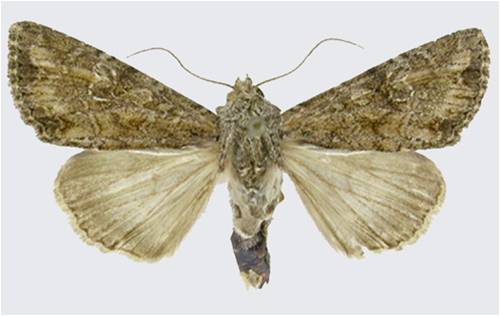Pests of Jute:: Major Pests ::Jute Semi-looper
2. Jute Semi-looper: Anomis sabulifera (Noctuidae: Lepidoptera)
Distribution and status: Jute tracts of India,Bangladesh, Myanmar,Sri Lanka and in parts of Africa.
Host range: Specific pest of jute and is the most destructive
Bionomics
The pest passes winter in soil in the pupal stage and the moths appear in May - June, when the crop begins to grow in the field. They lay eggs singly on the underside of young leaves; a female may lay more than 150 eggs which look like water droplets. Egg period 2-3 days. The tiny caterpillars, on emerging, feed on the apical leaves and buds undergo 5 moults, in about 17 days. The pupation takes place on the plant or in the soil. In. summer, the pupae emerge in about a week, but those, which diapause, spend the entire winter in that stage. The life-cycle is completed in about one month and several generations are completed in a year. |
|
Damage symptoms
The attack is severe on half-grown plants which are one metre high. They camouflage but are easily noticed when they crawl by producing a loop in the middle. The second generation is the most damaging and sometimes up to 90 per cent of the leaves may be eaten up. Generally, the top 7-9 leaves are damaged and plant growth is adversely affected, resulting in a considerable reduction in the yield of fibre.
Management
- Plough the infested fields after harvest to kill the pupae.
- Dislodge the caterpillars into kerosenized water by drawing a rope across the young crop.
- Conserve larval parasitoids Litomastix gopimobani (Encyrtidae), Tricholyga sorbillans and Sisyropa Formosa (Tachinidae).
- Spray endosulfan 35EC in 500 L of water per ha. Repeat the treatments three times at 15- day interval from mid June or at first appearance of the pest.
|
|

